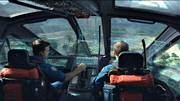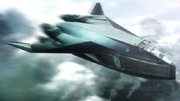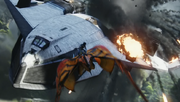| Valkyrie | |
|---|---|
| Machine Information | |
| Created by | |
| Used by | |
| Type | |
| Size |
|
| Speed |
|
| Behind the scenes | |
| First appearance | |
The Valkyrie SSTO (Single Stage To Orbit)-TAV-37 B-class shuttlecraft (Na'vi name: shah-tell) is a delta-wing transatmospheric vehicle primarily used to transport equipment, raw materials such as unobtanium, and personnel between the ISV Venture Star and Hell's Gate on the moon Pandora. Valkyries have an operational range of 2000 kilometers in the Pandoran atmosphere. The Valkyrie has a payload of up to 60 armed troops, 25 AMP suits, 25 tons of refined unobtanium and/or supplies.

Valkyrie cockpit
The two Valkyries carried by the ISV are used to transfer personnel and cargo between the orbiting ISV and the surface of Pandora. These vessels are left at Pandora, and the old Valkyrie craft are re-purposed to serve as automated gas harvesters, skimming through Polyphemus' upper atmosphere to obtain anti-hydrogen and deuterium for refueling the ISV. Each has VTOL capabilities by pivoting the engines for landing on the planet, and the Valkyrie's powerful fusion power plant provides enough energy to power the engines for hours at a time, which allows the shuttle to function as a low speed aerial platform for exploration and survey roles. As seen in the picture (upper right), a Valkyrie is landing at Hell's Gate.
Atmospheric Descent and Ascent

The Valkyrie in flight.
Valkyries enter the dense Pandoran atmosphere after decoupling from an ISV from a low delta-v orbit. As it hits the Pandoran atmosphere, the hypersonic re-entry speed generates shock heating. Carbon fiber thermal tiling on its ventral surface protects the Valkyrie during the descent. As it decelerates in the upper atmosphere, it vectors towards its only landing site, Hell's Gate. At 10,000 feet of altitude, where the atmosphere is thick enough, the air-breathing turbojet engines are activated. They provide forward propulsion until the shuttle is on the final approach to Hell's Gate. When the mining pit is spotted, the engines are transitioned to VTOL mode, which slows the shuttle, and allows for better maneuverability. As the shuttle approaches landing, it hovers on thrust from the four-poster lift engines, then settles to the ground as thrust is throttled back.
In order to reach orbit, the shuttle rises in hover and the engines are vectored slightly aft to begin forward acceleration. The shuttle then transitions to wing-borne forward flight at 130 knots, with the engines now aligned longitudinally for forward thrust. It then accelerates to supersonic speed on the turbojet engines. As it approaches Mach 3, hypersonic inlets open and the Valkyrie goes into scram-jet mode. It steadily accelerates at 3G's to Mach 7, and then transitions from turbojet to the fusion orbital engine for the final burn to orbit.

The Valkyrie is destroyed.
A Valkyrie was fitted with machine-gun nests on the wings and cargo ramp and was going to be used to deliver two Daisy Cutter explosive packages to the Tree of Souls. It was destroyed when Jake Sully, in his avatar, threw grenades into the engine intake after the explosives had been armed, causing the Valkyrie to tip forward and the explosives packages to fall back inside the hold. The left wing of the ship was sheared off as it struck one of the stone arches; on impact with the ground, the explosives detonated while still inside the Valkyrie, causing the entire ship to disintegrate in a massive fireball. The second Valkyrie was seen being used to ferry many of the remaining base personnel of Hell's Gate back to orbit, leaving their equipment behind.
Technical Details
The Valkyrie is roughly four times the size of the twentieth-century Earth space shuttles. Because it uses fusion engines, the Valkyrie can redirect its containment fields for active EMF damping, so it can function very well in the high magnetic field areas of Pandora. It does not rely solely on passive shielding. The Valkryie cargo bay can hold troops, AMP suits, all necessary ammo and gear, plus larger payloads such as specialized electronics and lab equipment that cannot be manufactured on Pandora. The inside of the bay looks much like any terrestrial cargo airplane, with netting to secure payloads to the walls, rollers built into the floor to facilitate unloading, lock bars for the AMP suits, and seats for RDA security forces. But its most important mission is the transportation of refined unobtanium from the surface of Pandora back to the orbiting ISV. Without this capability, there would be little or no human presence on Pandora. It is also the only possible ride back to the mother ship, and thus the one link with the long journey back to Earth.
The Valkyrie rides on a plume from its dual-mode fusion engine so powerful that it is visible at night from Hell’s Gate almost all the way to orbit (though it disappears over the horizon before orbital velocity is reached). Though it reaches orbit in less than ten minutes, the Valkyrie requires an additional six hours to maneuver to rendezvous and hard-dock with the ISV. Despite its size, the Valkyrie's mass is relatively small due to a fuselage fashioned from extremely strong non-metallic composite material. The material has high tensile strength, but only one quarter of the weight of the permalloys used in previous shuttles. The superstructure uses carbon nanotube composite in key locations to maximize stability and help conserve fuel. The two exhaust nozzles of the orbital engines face aft, and the engine nacelles are heavily shielded from the cargo bay. The least radioactive sections of the reactor directly parallel the bay. There is a rear ramp that lowers for the unloading of large vehicles and AMP suits. There are fold-down stools with passive restraints for the individual passengers which line both long walls of the bay. The AMP suit racks are located in the middle of the cargo bay in a double row. The cargo bay is a double deck design which allows the ISV cargo modules to be stacked two-high inside the bay. Cargo modules are transferred from the shuttle to the ISV by a large robotic arm which travels along the longitudinal spine of the starship on a mobile transporter base.
Trivia
- In the Vietnam War, BLU-82B/C-130 (commonly called "daisy cutter") were delivered by C-130 Hercules transports which were dropped out of the cargo ramp and descended by parachute to create instant landing zones ("LZ"). The resulting explosion left a distinctive crater in the shape of a daisy. The Hercules was used to "shuttle" supplies to forward bases such as Khe Sanh. Machine guns were sometimes mounted on the cargo ramps of HH-53 "Jolly Green Giant" helicopters in Vietnam and now CV-22s for self-protection in the absence of dedicated gun turrets.
- There are some similarities to the Valkyrie from Warhammer 40k.
- The craft also bears similarities to the real world XB-70 Valkyrie, most notably the delta wing design.
- The Valkyrie bears a vague resemblance to the Pelican dropship in the Halo games. Ironically, the Pelican was inspired by the dropship in Aliens, one of James Cameron's other films.
Sources
- Pandorapedia - Valkyrie Shuttle article
- James Cameron's Avatar: An Activist Survival Guide, page 158
| See the image gallery for Valkyrie
|